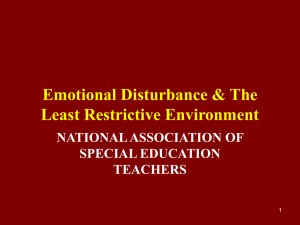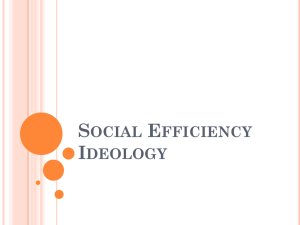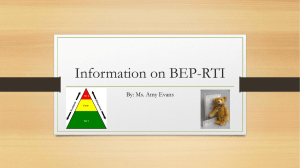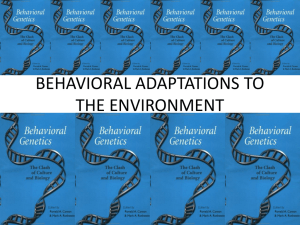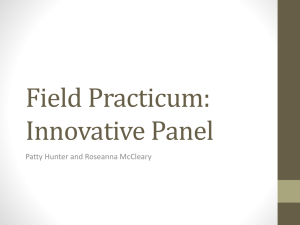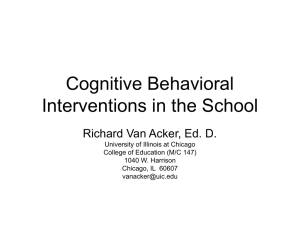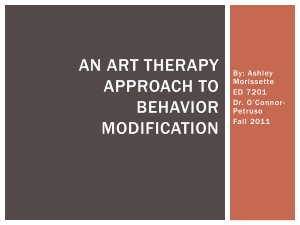Copy (2) of Emotional Behavioral Disorder
advertisement
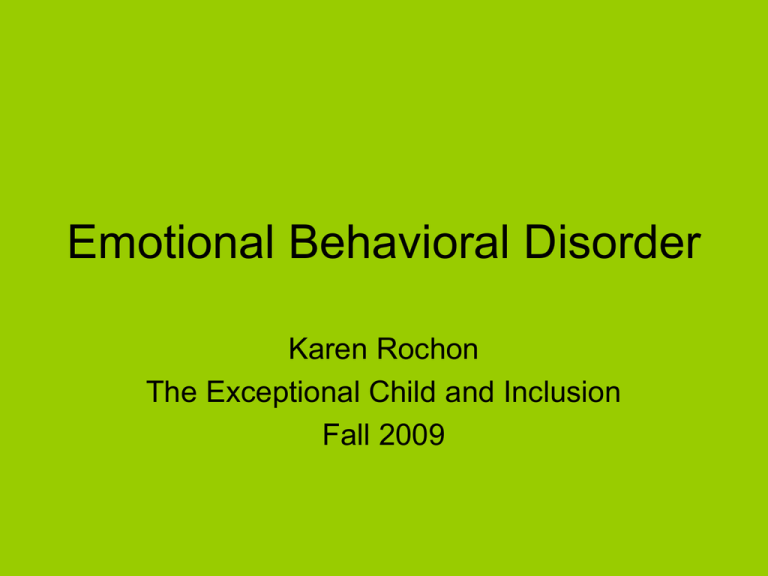
Emotional Behavioral Disorder Karen Rochon The Exceptional Child and Inclusion Fall 2009 What is Emotional Behavior Disorder? Behavior that goes to an extreme-not just slightly different from the usual. A problem that is chronic-one that does not quickly disappear. Behavior that is unacceptable because of social or cultural expectations. Problems with definition. (Exceptional Learners, p. 266) Classification Externalizing-acting out behavior; aggressive or disruptive behavior that is observable as behavior directed toward others. Exceptional Learners p. 268 Internalizing-acting in behavior; anxiety, fearfulness, withdrawal, and other indications of an individual’s mood or internal state. Prevalence Credible studies world wide have consistently indicated that at least 6 to 10 % of children of school age exhibit serious and persistent emotional/behavioral disorders. Less than 1% of schoolchildren in the U.S. are identified as emotionally disturbed for special education purposes. Exceptional Learners p.269 External Behavioral Characteristics of EBD Exposure to family, neighborhood school and community risk factors. Leads to antisocial behavior. Exceptional Learners p. 271 Produces negative short-term outcomes. Leads to negative, destructive, long-term outcomes. Internal Characteristics of EBD Students with internalizing problems (anxiety, fearfulness, withdrawal) might be less obvious, but they aren’t difficult to recognize. Teachers tend to under-refer students with internalizing problems. Not motivating to screen for these problems when there are not the services to treat them. Exceptional Learners p. 275 Educational Considerations Classroom Structure APPENDIX D Evidence-Based Behavior-Management Strategies for K-3 Teachers Working With Students With Emotional and Behavioral Disorders in the General Education Classroom __________________________________________________________________ Behavior Management Strategies 1. Establish positively stated rules regarding observable behavior. 2. Post, teach, and review rules periodically. 3. Post and review daily schedules, routines, and transitions. 4. Alert students to any changes in routine. 5. Model and provide explicit practice for classroom procedures. 6. Schedule a quiet activity between recess and independent seatwork. 7. Alternate between passive and active activities. 8. Deliver high-probability directives (ones that students will most likely comply with) before delivering low-probability directives. • Niesyn, Mary E., Strategies for Success: Evidence-Based Instruction Practices for Students With Emotional and Behavioral Disorders. Preventing School Failure, v53 n4 p227-233 Summer (2009) Educational Considerations Classroom Management Appendix C Evidence-Based Instructional Practices for K-3 Teachers With Students With Emotional and Behavioral Disorders in the General Education Classroom _______________________________________________________________________ Instructional practices 1.Give frequent, immediate, and specific praise (could be subtle). 2.Present materials individually, shorten assignments, and reveal few problems at a time. 3.Interact with student during independent seatwork. 4.Implement peer-tutoring opportunities. 5.Frontload questions with required information to increase correct responses. 6.Delay independent seatwork until student can perform task with 90% accuracy. 7.Embed student interests into curricular activities. 8.Allow student to choose from a few academic activities during independent seatwork. 9.Teach new concepts using explicit direct instruction method. • Niesyn, Mary E., Strategies for Success: Evidence-Based Instruction Practices for Students With Emotional and Behavioral Disorders. Preventing School Failure, v53 n4 p227-233 Summer (2009) I.E.P Requirements Development and implementation of positive behavioral intervention plans with students who have emotional and/or behavioral disorders. 1. 2. 3. 4. • Emphasis should be on the use of positive behavioral intervention plans and supports as encouraged by the 1997 Amendments to the Individuals With Disabilities Education Act. Four Key points to consider: Develop and implement a behavioral intervention plan (B.I.P.) including plan elements, strategies to address behavior functions, student supports and reinforcements. Monitor faithfulness of implementation of the plan. Evaluate effectiveness of the B.I.P. Modify the B.I.P. Gayle, Robert A., Quinn, Mary Magee, Rutherford, Robert B. Jr., Addressing Student Problem Behavior Part III Creating Positive Behavioral Intervention Plans and Supports 1st Edition. (2000) pp. 62 Strategies and Interventions different needs require different placements Specialized environment for students with the most severe emotional or behavioral disorders Intensive Individualized Highly structured Very high adult-student ratios Exceptional Learners p. 287-289 Regular education classroom environment 1. Know prevention and intervention strategies for individuals who are at risk of emotional or behavioral disorders. 2. Use a variety of nonaversive techniques to control targeted behavior and maintain attention of individuals with emotional or behavioral disorders. 3. Establish a consistent classroom routine, and use skills in problem solving and conflict resolution. 4. Plan and implement individualized reinforcement systems and environment modifications at levels equal to the intensity of the behavior. 5. Integrate academic instruction, affective education, and behavior management for individuals and groups. 6. Assess appropriate and problematic social behaviors of individuals. Strategies and Interventions Early intervention holds particular promise. 1. Children and their families who access mental and physical care are less likely to have behavioral and social problems. 2. Nurturing and positive parenting is associated with children who have healthy relationships and reduced challenging behavior. 3. High quality early education environments and caregiver interactions are associated with fewer behavior problems and the development of social competence. Exceptional Learners p. 295 Strategies and Interventions Visual and Oral Feedback Data suggest that the combination of oral and visual feedback improved the student’s appropriate behavior better than did oral feedback alone. APPENDIX B Tips on Giving Verbal and Visual Feedback (From J. Hattie & H. Timperley, 2007) Teacher should: Clarify goals with student. Provide immediate feedback. Use behavior-specific or task-related feedback. Conduct private feedback conferences, use data to provide feedback, monitor progress, and refine interventions as needed. • Lingo, Amy S., Jolivette, Kristine, & Barton-Arwood, Sally M. Visual and Oral Feedback to Promote Appropriate Social Behavior for a Student With Emotional and Behavioral Disorders. Preventing School Failure, v54 n1 p.24-29 Fall (2009) Teacher should avoid: Unrealistic goals. Generic praise or personal feedback. Delays in feedback. Assessment of Progress Progress Monitoring and Outcome Measures should measure students with EBD interpersonal skills, study skills, motivation, and engagement. Rating scales (Formal) Direct observation FBA’s (Functional Behavioral Assessments). Evaluation that consists of finding out the consequences (what purpose the behavior serves), antecedents (what triggers the behavior), and setting events (contextual factors) that maintain inappropriate behaviors. Exceptional Learners p. 291 Majority of FBA/BIPs exhibit serious flaws 1. Failure to identify specific target behaviors 2. Failure to verify the hypothesized function of the behavior (why). 3. Failure to connect the function of the behavior to the specific interventions identified in the BIP. (If a student skipped class to avoid the work, the student would be suspended). Exceptional Learners p. 292-293 References • Gayle, Robert A., Quinn, Mary Magee, Rutherford, Robert B. Jr., Addressing Student Problem Behavior Part III Creating Positive Behavioral Intervention Plans and Supports 1st Edition. (2000) pp. 62 • Hallahan, Daniel P., Kauffman, James M., & Pullen, Paige C. (2009) Exceptional Learners An Introduction to Special Education. Boston: Pearson • Lingo, Amy S., Jolivette, Kristine, & Barton-Arwood, Sally M. Visual and Oral Feedback to Promote Appropriate Social Behavior for a Student With Emotional and Behavioral Disorders. Preventing School Failure, v54 n1 p.24-29 Fall (2009) • Niesyn, Mary E., Strategies for Success: Evidence-Based Instruction Practices for Students With Emotional and Behavioral Disorders. Preventing School Failure, v53 n4 p227-233 Summer (2009)

